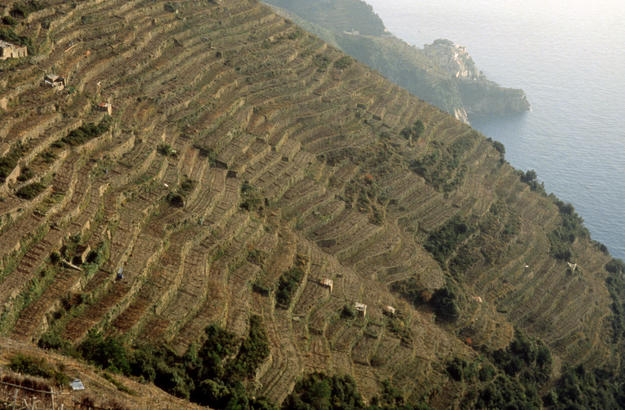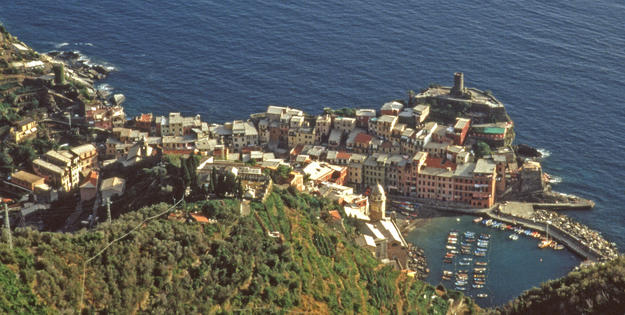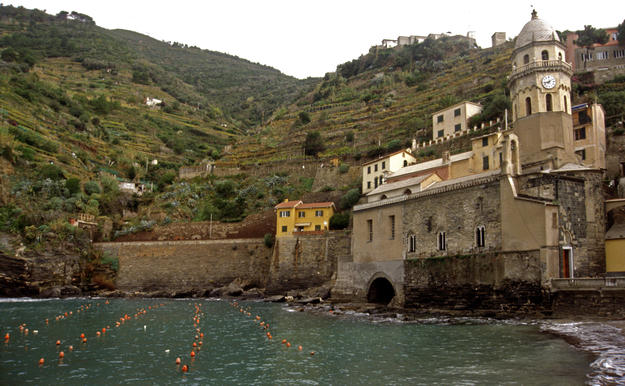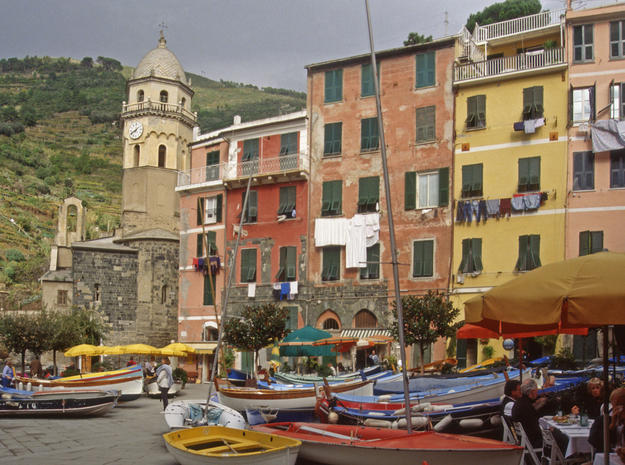2000 and 2002 World Monuments Watch
Cinque Terre runs along the Mediterranean coastline between Genoa and Tuscany, where the hills are carved into green terraces that descend toward the water. In the thirteenth century, the citizens of the Levante Riviera transformed their rocky environment into arable land, creating nine miles (14.5 kilometers) of terraced landscape with over 1,200 miles (1,930 kilometers) of stone drywall buttresses. For hundreds of years, Italians cultivated grapes and other crops in the hills above the five Ligurian towns of Monterosso, Riomaggiore, Vernazza, Coriglia, and Manarola. The region became famous for the quality of its wines and the verdant beauty of its sculpted topography. In the twentieth century, many of the vineyards were abandoned when the local owners found themselves unable to compete with the high production and low costs of larger commercial wineries elsewhere in Europe. In 1973, the Italian government marked Cinque Terre as a valuable national landscape by bestowing it with a Document of Controlled Origin (D.O.C.), and in 1997 the region was added to the UNESCO World Heritage List. However, neither of these gestures reversed the trend of the vineyards’ desertion.
Conservation work and a management plan lead to the protection of cultural history
At the turn of the twenty-first century, only a small section of Cinque Terre was still being used for agricultural production and the populations of the towns in the region were shrinking. Due to increasing lack of maintenance, the stone buttresses that supported the terraces were collapsing and causing landslides toward the buildings below. Cinque Terre was included on the World Monuments Watch in 2000 in order to draw attention to the impending loss of a vibrant and valuable cultural landscape. We strongly believed that the solution to this problem would depend on making the terraces economically viable again through collaboration with local communities. Almost immediately after the announcement of the Watch in October 1999 a national park was established at Cinque Terre, and in the months that followed the Italian Ministry of the Environment contributed funds for the repair of the terraces. In 2000 we secured an American Express grant to finance a study for the planning and conservation of the terraced land of Cinque Terre, which included architectural surveys and documentation, materials analysis, training of local researchers, and strategic planning for development and sustainable tourism.
Cinque Terre was included on the Watch again in 2002, and in May of that year the Italian regional government of Liguria committed finances to the site. Further funding from American Express was used to create usable tools for the site’s development from the information gathered during the last Watch cycle. For example, guides for the site’s sustainable development and the conservation of its dry stone walls were compiled, and a Geographic Information System (GIS) organized data collected from surveys. This study was completed in 2004 and was a crucial tool in the subsequent creation of a site management plan.
In February 2016, the Italian government announced that it would be introducing a ticketing system for visitors to Cinque Terre in order to manage tourism in the area’s small towns. The new scheme is set to be implemented in the summer of 2016, with the objective of better preserving the region’s culture.
Along the Mediterranean coast in northern Italy, the cultural landscape of Cinque Terre provides a powerful example of the way that humans can alter and shape their own environment. Our involvement in the region prompted positive changes both in the management the landscape and in its physical condition.




